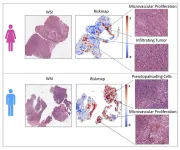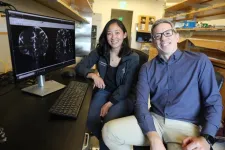UW–Madison researchers use AI to identify sex-specific risks associated with brain tumors
2024-10-07
(Press-News.org) MADISON — For years, cancer researchers have noticed that more men than women get a lethal form of brain cancer called glioblastoma. They’ve also found that these tumors are often more aggressive in men. But pinpointing the characteristics that might help doctors forecast which tumors are likely to grow more quickly has proven elusive. University of Wisconsin–Madison researchers are turning to artificial intelligence to reveal those risk factors and how they differ between the sexes.
Radiology and biomedical engineering professor Pallavi Tiwari and her colleagues have published their initial findings in the journal Science Advances, hinting at the promise of AI for improving medical care for cancer patients.
“There’s a ton of data collected in a cancer patient’s journey,” says Tiwari, who is also affiliated with the department of medical physics. “Right now, unfortunately, it’s usually studied in a siloed fashion, and this is where AI has huge potential.”
Few researchers better understand this potential than Tiwari. Arriving at UW–Madison in 2022 to help lead the university’s new AI initiative in medical imaging, Tiwari co-directs the Imaging and Radiation Sciences Program at the Carbone Cancer Center. Her research leverages the computational power of AI models to probe large volumes of medical images and find patterns that could help oncologists and their patients make better-informed decisions.
“We want to address the entire spectrum of challenges in a cancer patient’s journey, starting from diagnosis and prognosis to treatment response assessment,” says Tiwari.
In this case, Tiwari and former graduate student Ruchika Verma turned to digital images of pathology slides — thin slices of tumor samples — in search of patterns that might forecast how quickly a tumor could grow and thus how long a patient might expect to survive.
Glioblastoma is one of the most aggressive forms of cancer, with a median survival of 15 months after diagnosis.
“Patients often don’t have long lives after diagnosis,” says Tiwari. “But a big challenge is prognosis — identifying how long patients are actually going to live and what their outcome is likely to be. This is important because the outcomes ultimately govern the treatments that they’re getting and their quality of life after diagnosis.”
To tackle this challenge, Tiwari and Verma built an AI model that can identify even subtle patterns in pathology slides that might never be apparent to the naked eye. Using data from more than 250 studies of glioblastoma patients, they trained the model to recognize tumors’ unique characteristics, such as the abundance of certain cell types and the degree to which they invade surrounding healthy tissue.
Further, they trained the model to identify any patterns between these characteristics and patients' survival time while accounting for their sex.
In doing so, they developed an AI model that was able to identify risk factors for more aggressive tumors that are strongly associated with each sex. For females, higher-risk characteristics included tumors that were infiltrating into healthy tissue. Among males, the presence of certain cells that surround dying tissue (called pseudopalisading cells) was associated with more aggressive tumors.
The model also identified tumor characteristics that appear to translate to worse prognoses for both men and women.
The study could help lead to more individualized care for glioblastoma patients.
“By uncovering these unique patterns, we hope to inspire new avenues for personalized treatment and encourage continued inquiry into the underlying biological differences seen in these tumors,” Verma says.
Tiwari and her colleagues are doing similar work using MRI data and have begun using AI to analyze pancreatic and breast cancers with the aim of improving outcomes for patients.
In addition to her research, Tiwari is helping to shape the university’s RISE-AI and RISE-THRIVE initiatives, which are establishing UW–Madison as a leader of cross-disciplinary research on artificial intelligence and the human health span, respectively.
“UW has a rich and diverse expertise across our engineering and medical campuses,” says Tiwari, “and with the RISE initiatives, we are well positioned to be at the forefront of translating AI research in clinical care.”
# # #
--Will Cushman, wcushman@wisc.edu, 608-263-1986
END
ELSE PRESS RELEASES FROM THIS DATE:
2024-10-07
George Mason Researchers Conducting AI Exploration For Snow Water Equivalent Forecasting In Western U.S. With Physics-Informed Neural Network & GeoWeaver
Ziheng Sun, Research Assistant Professor, Center for Spatial Information Science and Systems (CSISS), Geography and Geoinformation Science, College of Science; Mingrui Liu, Assistant Professor, Computer Science, College of Engineering and Computing (CEC); and Keren Zhou, Assistant Professor, Computer Science, CEC, are studying the dynamics of snow water equivalent (SWE).
SWE measures the amount of water available in snow.
The researchers will use ...
2024-10-07
Sarah Huskisson, PhD candidate, Environmental Science and Policy, College of Science, is characterizing the gastrointestinal (GI) health of red pandas using short-chain fatty acid (SCFA) concentrations. Huskisson is advised by Elizabeth Freeman, Associate Professor, School of Integrative Studies. Huskisson is co-Principal Investigator on the project.
Huskisson and Freeman aim to provide the first characterization of SCFA concentrations for red pandas and hope that differences in concentrations can be pinpointed between healthy and mucoid/loose stools.
They have two hypotheses.
First, they hypothesize that ...
2024-10-07
Scientists have long theorized about a network of pathways in the brain that are believed to clear metabolic proteins that would otherwise build up and potentially lead to Alzheimer’s and other forms of dementia. But they had never definitively revealed this network in people — until now.
A new study involving five patients undergoing brain surgery at Oregon Health & Science University provides imaging of this network of perivascular spaces — fluid-filled structures along arteries and veins — within the brain for the first time.
“Nobody has shown it before now,” said senior author Juan Piantino, ...
2024-10-07
EXPERT AVAILABLE
Embargoed until Tuesday 8 October at 06:00 AEDT
New research from the University of Sydney shows that international conservation efforts account for approximately 10 percent of fish stocks on coral reefs.
The global study, published in Proceedings of the National Academy of Sciences, was led by Professor Joshua Cinner from the School of Geosciences and lead analyst Dr Iain Caldwell from the Wildlife Conservation Society. The international research team also included scientists from US, UK, Kenya, France and Germany among others.
Looking at fish survey data across nearly 2,600 tropical ...
2024-10-07
An international research team led by the University of Vienna and the Medical University of Vienna has used long-term demographic data from Japanese macaques – a monkey species within the family of Old World monkeys – to show that, unlike humans, there is no maternal mortality in these primates linked to childbirth. The results of the study were recently published in the renowned scientific journal PNAS.
The evolution of large brains and associated large fetal heads are key factors linked to maternal mortality in primates during childbirth. For humans, the baby's large head in relation ...
2024-10-07
Five George Mason Researchers Receive Funding For Center For Climate Risks Applications
Luis Ortiz, Assistant Professor, Atmospheric, Oceanic and Earth Sciences (AOES), College of Science; Fengxui Zhang, Assistant Professor, Schar School of Policy and Government; Edward Oughton, Assistant Professor, Geography and Geoinformation Science, College of Science; Natalie Burls, Associate Professor, AOES, and Director, Climate Dynamics Program, College of Science; and James Kinter, Director, Center for Ocean-Land-Atmosphere Studies (COLA); Director, ...
2024-10-07
CRISPR is a revolutionary tool that allows scientists to precisely modify the genome and gene expression of cells in any organism. It’s a reagent—a substance that facilitates a reaction—that combines an enzyme with a programmable RNA capable of locating specific genetic sequences. Once guided to the correct spot, the enzyme acts like a pair of scissors, cutting, replacing, or deleting sequences of DNA.
Researchers are now using the technology to, among many things, treat genetic diseases, develop medical therapeutics, and design diagnostic tools.
“CRISPR is very powerful, but it comes with side effects,” says Lehigh University ...
2024-10-07
Weill Cornell Medicine researchers found that the possibility of parental disclosure through online patient portals led older adolescents to hesitate in sharing complete health information with doctors, putting them at risk of missed diagnoses and treatments. The paper noted that confidentiality concerns were increased among females and those who are sexual and gender minorities.
The results, published Oct. 7 in JAMA Pediatrics, are based on a national online survey that targeted 18 to 26 years olds who ...
2024-10-07
Benjamin Gatling, Associate Professor, English, College of Humanities and Social Sciences (CHSS), is set to receive funding for a project in which he will digitize a significant portion of the archive of the Folklore Fund at the Rudaki Institute of Language and Literature in Dushanbe, Tajikistan.
Gatling aims to train local archive staff in best practices, the preservation of materials, and digitization and metadata creation for the majority of the archive’s holdings, as well as the curation of digitized materials.
The archive’s holdings include bound notebooks, notecards, ...
2024-10-07
INDIANAPOLIS -- Jill Inderstrodt, PhD, MPH, has received notification of a five-year, $1.9 million collaborative grant to improve health and the care of people living with congenital heart defects (CHD).
Awarded by the Centers for Disease Control and Prevention, Dr, Inderstrodt will lead a multidisciplinary team from the Indiana University Fairbanks School of Public Health and the Regenstrief Institute. Also part of the research team is Brian Dixon, PhD, MPA, a Regenstrief researcher, Fairbanks School professor and interim director of the Regenstrief Center for Biomedical Informatics.
“I am honored to lead this initiative alongside ...
LAST 30 PRESS RELEASES:
[Press-News.org] UW–Madison researchers use AI to identify sex-specific risks associated with brain tumors






